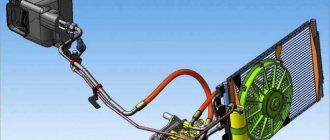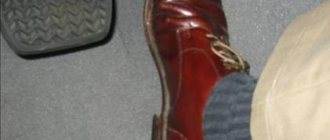VAZ 2108 (or “Eight”, “Chisel” or “Sputnik”) is a small-class car, the production of which was carried out in the USSR, and subsequently in Russia, from 1984 to 2003 by the Volzhsky Automobile Plant. In 2004, the conveyor was stopped and the 2108 was replaced by the VAZ model with the index 2113. During the entire production period, the VAZ model range was equipped with gasoline carburetor and injection engines with working volumes of 1.1, 1.3, 1.5 and 1.6 liters, paired only with a manual gearbox transmission All cars were front-wheel drive and are still very popular in Russia and Ukraine.
Technical characteristics of the VAZ 2108:
1. Engine
2. Dimensions
Other
Other characteristics
Drive unit
- Drive type:
Front
Transmission
- Transmission:
Manual
Suspension
- Front:
independent McPherson type - Rear:
trailing arm
Brakes
- Front:
disc - Rear:
b
Solex carburetor tuning
Tuning, that is, improvement, modification of the carburetor is carried out to increase engine power and improve driving dynamics.
Important! In order to achieve maximum power, there must be a minimum of resistance at the carburetor inlet. With high resistance, the quality of the mixture is not always “at its best” (sometimes “poor”, sometimes “rich”).
If you sharply open the throttle valve with the Solex carburetor set at the factory, the air flow speed decreases, as a result of which less gasoline is supplied to the carburetor. Because of this, power drops significantly at low speeds.
The procedure for increasing engine power by tuning the Solex carburetor:
- We carefully disassemble the carburetor.
- We wash and blow, and divide into two halves.
- Pay attention to the air damper axis. There are protruding screws on this axis, which creates additional resistance while the car is moving. Any little things are important when tuning, so these protruding screws need to be smoothed out.
- Remove the axle and air damper from the top. The axle needs to be sharpened.
- From the lower part you need to pull out the throttle valves with their axles. At this stage, using a file we make the flaps larger. We hide the screw caps inside the axle. There are screws with conical heads, you can use them. The throttle valve needs to be assembled.
- Now we are tuning the diffusers. To improve the aerodynamics of the diffusers, it is necessary to make the legs in the shape of wings. We also check the protrusions of the factory casting; if there are any, they need to be ground off.
- The accelerator pump must have 2 tubes installed in one chamber. There is an opinion among some that when I use two tubes for each camera, “dips” may appear, that is, you press on the gas, but the car does not move.
In general, the basis of tuning is smoothing, erasing protrusions and irregularities. Any unevenness in the fuel and air mixing chamber creates resistance.
Modifications
VAZ-21081
outwardly completely identical to the VAZ-2108, an engine with a volume of 1100 cm3 is installed. The model was mainly exported.
- The VAZ-21083
is completely identical in appearance to the VAZ-2108; it has a 1500 cm3 carburetor engine.
Since 2001, a new model configuration program has been adopted. As a result, the VAZ-21083 model received extended indexes, depending on the configuration:
- VAZ-21083-00 - standard equipment
- VAZ-21083-01 - “norm” equipment
- VAZ-21083-02 - luxury package
The first production injection model VAZ-21083 had the index VAZ-21083-20 and was released in 1994. Since 2001, a new model configuration program was adopted, as a result of which the configuration of the VAZ-21083-20 model was given the name “standard”.
- VAZ-21083-20 - standard equipment
- VAZ-21083-21 - “norm” equipment
- VAZ-21083-22 - luxury package
- VAZ-210834
- In 1998, based on models 21083 and 21213, the VAZ-210834 SUV with engine 21213 and Lada Tarzan with engine 21231 were developed. - VAZ-21084
is completely identical in appearance to the VAZ-2108, it has a 1600 cm3 engine. It is a VAZ-21083 engine with a block increased in height by 1.2 mm, a slightly modified head and a new crankshaft and camshaft. A piston with a diameter of 82 mm, cut in height by 1.8 mm, will have a stroke of 74.8 mm here. It was produced in small batches in pilot production conditions. - VAZ-21085
- identical to the VAZ-2108, but with a 16-valve injection engine with a volume of 1500 cm3 and a power of 93 hp. - VAZ-21086
is a VAZ-2108 model with a right-hand steering wheel. - VAZ-21087
- is a VAZ-21081 model with a right-hand steering wheel. - VAZ-21088
is a VAZ-21083 model with a right-hand steering wheel. - VAZ-21089
is completely identical in appearance to the VAZ-2108, but with a two-section VAZ-414 RPD with a power of 120 hp. It was produced in small batches until the appearance of the new RPD VAZ - 415. Then the VAZ-2108-91 model came to replace it.
Disassembling the housing Carburetor malfunction
| Problem: high fuel consumption VAZ-21093i - Cheboksary To check the level in the float chamber, the serviceability of the needle valve and floats, and to adjust the float mechanism, remove the carburetor cover. Indirect signs accompanying high fuel consumption are black carbon deposits on the spark plugs, pops or shots in the muffler, increased engine idle speed, black exhaust from the muffler, or exhaust with a persistent smell of gasoline, etc. |
| VAZ 21099: increased fuel consumption - what to do For the first chamber of the carburetor, which has a smaller cross-section than what you have installed, and idle fuel nozzles, they are inserted into the solenoid valve or a plug replacing it, on the contrary, with a larger cross-section than the existing ones. Before you tightly grasp the carburetor, be sure to make sure that the other systems are in good working order, the spark plugs are in working order, the high-voltage wires do not break through to ground, and the engine cylinders have compression, the minimum value for a VAZ 2108 is 11 Bar. |
- Pay attention to the color of the exhaust - oil fumes produce thick bluish smoke.
- Disconnect the crankcase ventilation pipe from the air filter housing and start the engine. If the compression rings are worn out, a bluish exhaust will come out of the hose.
- Measure compression in all cylinders while hot. The minimum acceptable value is 8.5-9 Bar.
- If the pressure gauge shows 1-3 bar pressure in the cylinder, the valve (or several valves) has become unusable.
The VAZ carburetor engine begins to require a lot of gasoline when there are malfunctions of the following parts.
- Problems with the power system (needles, carburetor jets, fuel pump).
- Wheel hub too tight.
- Broken camber - toe.
- The spark plug gaps are broken.
- Faulty thermostat.
- Low compression (compression) in the cylinders.
- Tire pressure is below normal.
- The ignition timing is incorrect.
Deviations in the internal balance of the carburetor result in up to 50 additional percent loss of gasoline. An increase in flow rate can cause misalignment of the needle valve needle, incorrect position of the main fuel jet, idle jet, or throttle valve. You should not overdo it when tightening the wheel hubs. In this case, the wheel becomes more clumsy, and a lot of force will be required to turn it at a certain angle. When driving in neutral gear, heavily tightened hubs stop the car from inertia ahead of time. As a result, up to 15% “overtime” fuel may be required.
In order not to waste another +15% of fuel, you definitely need to check the wheel alignment. This is the name given to the deviation of the wheel from the vertical plane of its installation. Due to the collapse of the wheel, the car needs more fuel to travel a particular section of the road.
If the spark plugs are not gapped correctly, the spark will not be strong enough. This leads to poor ignition of the combustible mixture. As a result, another 10% of fuel is consumed.
If the thermostat is broken, the engine does not reach the required operating temperature, which prevents all system mechanisms from working at full capacity. The system is forced to compensate for deviations from the optimal operation of the mechanisms with an additional amount of gasoline (up to 10%).
Compression (the amount of pressure in the piston at the end of the compression stroke) for the VAZ 2109 should be in the range of 9.5–13 atmospheres. If deviations from the norm occur, the cylinder walls and compression rings wear out. Over time, this adds up to 10% to costs.
The combustion efficiency of the combustible mixture is also affected by the ignition timing. If it is incorrectly set, a spark is formed when the crankshaft is in the wrong position, and the resulting mixture does not burn 100 percent. And to maintain a given power, the engine requires more fuel. According to measurements, a deviation from the angle of 1 degree causes an increase in gasoline costs by 1 percent.
Knowing what breakdowns cause high fuel consumption of the VAZ 2109, you can diagnose them in time.
TTX VAZ 2108
VAZ 2108 is a passenger three-door front-wheel drive hatchback, produced at the Volzhsky Automobile Plant from 1984 to 2003. The Eight became the first Russian car with front-wheel drive, which was not related in design and technology to the classic Zhiguli.
Below are the technical characteristics of the VAZ 2108. The table shows the main characteristics and parameters, body dimensions, type of suspension and steering, as well as permissible loads and weight of the car.
| Main settings | |
| Wheel formula / drive wheels | 4x2 / front |
| Body type / number of doors | hatchback / 3 |
| Car layout diagram | front-wheel drive, front engine, transverse |
| Ground clearance (ground clearance), mm | 170 |
| Fuel tank volume, l | 43 |
| Trunk volume, l | 330 (600) |
| Suspension and chassis | |
| Front suspension | independent, MacPherson-type shock-absorbing strut |
| Rear suspension | Semi-independent, torsion beam |
| Tire size | 165/70 R13 175/70 R13 175/75 R14 |
| Front brakes | disk |
| Rear brakes | drums |
| Wheelbase | |
| Wheelbase, mm | 2460 |
| Front track width, mm | 1400 |
| Rear track width, mm | 1370 |
| Weight, load capacity, permissible loads | |
| Weight, kg | 900 |
| Permissible total weight, kg | 1325 |
| Steering | |
| Steering type | worm gear |
| Dimensions | |
| Length, mm | 4006 |
| Width, mm | 1650 |
| Height, mm | 1402 |
Vehicle characteristics
Before you find out the real fuel consumption of the VAZ 2108 per 100 km, you need to know the main characteristics of the car:
- The driving wheels are front.
- Number of doors – 3, including the rear door.
- Seats in the cabin – 5.
The vehicle is versatile because the rear row of seats can be folded. This allows you to increase the luggage compartment to transport bulky cargo. Due to the folded sofa, the number of seats is reduced to two, but the useful weight increases to 425 kg; when the sofa is unfolded, it is recommended to transport 275 kg.
The weight of the VAZ 2108 is 900 kg, but if we talk about model 21083, then the curb weight is 15 kg more. According to the technical characteristics, the vehicle can reach the following maximum speed:
- VAZ 2108 – 148 km/h.
- VAZ 21081 – 139 km/h.
- VAZ 21083 – 156 km/h.
Acceleration to 100 km in the time frame differs depending on the model, varying between 13-17 seconds. When driving at 80 km/h, the braking distance will be 41.5 meters, provided the systems are in working order. If braking is carried out with a hand brake, the distance increases to 85 m.
As for driving performance and components, they have the following characteristics:
- The front suspension is independent, with shock-absorbing struts.
- The rear suspension is on coil springs.
Main advantages:
- Good handling.
- Maintainability.
- Large selection of spare parts.
- Good speed characteristics.
- Not bad dynamics.
- Reliable bumpers.
Today it is no longer possible to buy a new car, but it is possible to purchase a Lada Samara - an improved model.
Engine characteristics, fuel consumption and acceleration time
| Engine make | VAZ 21081 | VAZ 2108 | VAZ 21080 | VAZ 21083 | VAZ 21083 | VAZ 21083 | VAZ 2111 | VAZ 2112 |
| Engine capacity, cubic meters cm | 1100 | 1289 | 1300 | 1499 | 1499 | 1499 | 1499 | 1499 |
| Number of valves | 8 | 8 | 8 | 8 | 8 | 8 | 8 | 16 |
| Maximum power, hp | 54 | 64 | 63 | 68 | 72 | 76 | 79 | 93 |
| Transmission type | 4 manual transmission | 5 manual transmission | 4 manual transmission | 5 manual transmission | 5 manual transmission | 5 manual transmission | 5 manual transmission | 5 manual transmission |
| Speed at maximum power, rpm | 5600 | 5600 | 5600 | 5600 | 5600 | 5400 | 5400 | 5600 |
| Maximum torque, N*m | 79 | 95 | 95 | 100 | 109 | 116 | 116 | 128 |
| Speed at maximum torque, rpm | 3600 | 3400 | 3400 | 3400 | 3400 | 3000 | 3000 | 3700 |
| engine's type | in-line, 4-cylinder | |||||||
| Supply system | carburetor | carburetor | carburetor | carburetor | carburetor | carburetor | injector | injector |
| Recommended fuel | gasoline AI-92 | gasoline AI-92 | gasoline AI-92 | gasoline AI-92 | gasoline AI-92 | gasoline AI-92 | gasoline AI-95 | gasoline AI-95 |
| Fuel consumption | ||||||||
| Fuel consumption in the urban cycle, l/100 km | 8,7 | 8,6 | 9,1 | 8,7 | 8,8 | 9,9 | 9,9 | 8,8 |
| Fuel consumption in the extra-urban cycle, l/100 km | 5,6 | 5,4 | 5,4 | 5,7 | 5,8 | 5,7 | 5,7 | 5,5 |
| Fuel consumption in the combined cycle, l/100 km | 6,9 | 6,8 | 7 | 7,7 | 7,9 | 7,7 | 7,7 | 6,9 |
| Dynamic indicators | ||||||||
| Acceleration time 0-100 km/h, s | 17 | 16 | 16 | 14 | 13 | 14 | 14 | 13 |
| Maximum speed, km/h | 139 | 148 | 148 | 154 | 157 | 155 | 155 | 160 |
VAZ 2108 was initially equipped with four-cylinder 8-valve carburetor engines of 1.1, 1.3 and 1.5 liters. Since 1994, engines with distributed fuel injection began to be installed on cars. However, this did not stop the production of V8s with carburetor engines.
The main advantages that distinguished cars of this series from other cars of those years were the technical characteristics of the VAZ 2108. In particular, good handling, speed and dynamic qualities, ease of repair, strong front and rear bumpers that could withstand impacts at a speed of 40 km/h , made the car more and more popular every year. Production ceased in 2003.
VAZ-2109 real fuel consumption per 100 km: reviews
- Vitaly, Ufa. The car is from 1990, still my grandfather’s. Odometer reading is 300 thousand, no surprises. This is what the Soviet automobile industry means, at that time they made it for centuries. The undeniable advantage of this car is its very strong bumpers, which are practically not deformed in an accident. Indeed, this is the only safety element for my Lada. However, somehow I’m not in a particular hurry, and the car itself sets me up for a calm ride. The power unit is injection, 1.1 liters with 55 horsepower - from eight. A playful and practical motor, solid and easy to use. Fuel consumption is a maximum of 9-11 liters per hundred kilometers. On the highway, approximately 7 liters are consumed.
- David, Chrysostom. The car pleases with its comfortable interior, despite the spartan-style interior of the 1980s. All controls are working. Fuel consumption with a 1.1 engine is 9 liters. I turned on the gas and a characteristic smell appeared in the interior. Even the installers could not solve the problem. There is a need to drive with the windows open.
- Roman, Omsk. I liked the car, it was simple and easy to service. In the engine compartment there is an initial 1.1-liter injection engine that produces 54 horsepower. The maximum speed with it is 150 km/h according to the passport, but in real life the pleasant speed is 120-130 km/h. Fuel consumption is 9 liters per hundred kilometers.
VAZ 2108 dimensions and weight
Dimensions Lada 2108 restyling 1991, hatchback 3 doors, 1st generation
04.1991 — 09.2004
| Options | Dimensions | Weight, kg |
| 1.1MT 21081 | 4006 x 1650 x 1402 | 900 |
| 1.3MT 21080 | 4006 x 1650 x 1402 | 900 |
| 1.3MT 21086 | 4006 x 1650 x 1402 | 900 |
| 1.5 MT 21085-20 Standard | 4006 x 1650 x 1402 | 905 |
| 1.5i MT 21085-21 Normal | 4006 x 1650 x 1402 | 905 |
| 1.5i MT 21085-22 Lux | 4006 x 1650 x 1402 | 905 |
| 1.5 MT 21083-00 Standard | 4006 x 1650 x 1402 | 915 |
| 1.5 MT 21083-01 Norm | 4006 x 1650 x 1402 | 915 |
| 1.5 MT 21083-02 Lux | 4006 x 1650 x 1402 | 915 |
| 1.5 MT 21083-00 Standard | 4006 x 1650 x 1402 | 920 |
| 1.5 MT 21083-01 Norm | 4006 x 1650 x 1402 | 920 |
| 1.5 MT 21083-02 Lux | 4006 x 1650 x 1402 | 920 |
| 1.5i MT 21083-20 Standard | 4006 x 1650 x 1402 | 920 |
| 1.5i MT 21083-21 Normal | 4006 x 1650 x 1402 | 920 |
| 1.5i MT 21083-22 Lux | 4006 x 1650 x 1402 | 920 |
| 1.6MT 21084 | 4006 x 1650 x 1402 | 920 |
| 1.3MT 2108-91 | 4006 x 1650 x 1402 | 1015 |
Dimensions Lada 2108 1984, hatchback 3 doors, 1st generation
10.1984 — 08.1993
| 1.1MT 21081 | 4006 x 1650 x 1402 | 900 |
| 1.3MT 21080 | 4006 x 1650 x 1402 | 900 |
| 1.3MT 21086 | 4006 x 1650 x 1402 | 900 |
| 1.5 MT 21085-20 Standard | 4006 x 1650 x 1402 | 905 |
| 1.5i MT 21085-21 Normal | 4006 x 1650 x 1402 | 905 |
| 1.5i MT 21085-22 Lux | 4006 x 1650 x 1402 | 905 |
| 1.5 MT 21083-00 Standard | 4006 x 1650 x 1402 | 920 |
| 1.5 MT 21083-01 Norm | 4006 x 1650 x 1402 | 920 |
| 1.5 MT 21083-02 Lux | 4006 x 1650 x 1402 | 920 |
| 1.5i MT 21083-20 Standard | 4006 x 1650 x 1402 | 920 |
| 1.5i MT 21083-21 Normal | 4006 x 1650 x 1402 | 920 |
| 1.5i MT 21083-22 Lux | 4006 x 1650 x 1402 | 920 |
| 1.3MT 2108-91 | 4006 x 1650 x 1402 | 1015 |
Possible problems when setting up XX
When the quantity screw is tightened, the engine does not react at all . This problem can occur when a large amount of fuel enters the idle diffuser. There may be several reasons for this:
- an XX jet of a larger size than necessary is installed;
- the plug or solenoid valve is not tightened properly, so gasoline is sucked in, bypassing the XX jet;
- The jet or its seat is deformed.
To identify the specific cause of the above problem, it is necessary to disconnect the wire from the valve while the engine is running, and the motor should immediately turn off. If this happens, most likely the wrong size XX jet is installed. When the engine does not stall when the power supply to the valve is turned off, it means that fuel is supplied bypassing the exhaust system, including the nozzle itself.
To eliminate the malfunction, first remove the plug or solenoid valve and check the condition of the nozzle and seat for any deformations. If the seat is damaged, you will have to replace the carburetor cover. If no damage or deformation is detected, put the jet on the solenoid valve and lubricate the o-ring with oil. Then we tighten the nozzle with a wrench, holding it with one finger without much effort.
Fuel consumption VAZ 2108
Fuel consumption Lada 2108 restyling 1991, hatchback 3 doors, 1st generation
04.1991 — 09.2004
| Modification | Fuel consumption, l/100 km | Fuel used |
| 1.3 l, 63 hp, gasoline, manual transmission, front-wheel drive | 5,4 | Gasoline AI-95 |
| 1.1 l, 54 hp, gasoline, manual transmission, front-wheel drive | 5,6 | Gasoline AI-95 |
| 1.3 l, 64 hp, gasoline, manual transmission, front-wheel drive | 6,8 | Gasoline AI-95 |
| 1.5 l, 79 hp, gasoline, manual transmission, front-wheel drive | 7,7 | Gasoline AI-95 |
| 1.5 l, 76 hp, gasoline, manual transmission, front-wheel drive | 7,7 | Gasoline AI-95 |
| 1.5 l, 68 hp, gasoline, manual transmission, front-wheel drive | 7,7 | Gasoline AI-95 |
| 1.5 l, 93 hp, gasoline, manual transmission, front-wheel drive | 8,8 | Gasoline AI-95 |
| 1.3 l, 140 hp, gasoline, manual transmission, front-wheel drive | 10,0 | Gasoline AI-95 |
Fuel consumption Lada 2108 1984, hatchback 3 doors, 1st generation
10.1984 — 08.1993
| 1.3 l, 63 hp, gasoline, manual transmission, front-wheel drive | 5,4 | Gasoline AI-95 |
| 1.1 l, 54 hp, gasoline, manual transmission, front-wheel drive | 5,6 | Gasoline AI-95 |
| 1.3 l, 64 hp, gasoline, manual transmission, front-wheel drive | 6,8 | Gasoline AI-95 |
| 1.5 l, 79 hp, gasoline, manual transmission, front-wheel drive | 7,7 | Gasoline AI-95 |
| 1.5 l, 76 hp, gasoline, manual transmission, front-wheel drive | 7,7 | Gasoline AI-95 |
| 1.5 l, 68 hp, gasoline, manual transmission, front-wheel drive | 7,7 | Gasoline AI-95 |
| 1.5 l, 93 hp, gasoline, manual transmission, front-wheel drive | 8,8 | Gasoline AI-95 |
| 1.3 l, 140 hp, gasoline, manual transmission, front-wheel drive | 10,0 | Gasoline AI-95 |
Carburetor malfunction
They should be divided into two parts - metallic and non-metallic. We wash the metal ones with acetone (or a similar cleaning liquid), clean them, blow them with compressed air, but do not need to wash the non-metallic ones (membranes, gaskets, O-rings...). We inspect and reject defective parts (torn membranes, gaskets, O-rings, etc.). We check the markings of the jets with the parameters specified for each modification. For everything related to cleaning and cleaning the carburetor, see here “Cleaning and cleaning Solex and Ozone carburetors.”
Tank volume VAZ 2108
Tank volume Lada 2108 restyling 1991, hatchback 3 doors, 1st generation
04.1991 — 09.2004
| Options | Fuel tank volume, l |
| 1.1MT 21081 | 43 |
| 1.3MT 2108-91 | 43 |
| 1.3MT 21080 | 43 |
| 1.3MT 21086 | 43 |
| 1.5 MT 21083-00 Standard | 43 |
| 1.5 MT 21083-01 Norm | 43 |
| 1.5 MT 21083-02 Lux | 43 |
| 1.5i MT 21083-20 Standard | 43 |
| 1.5i MT 21083-21 Normal | 43 |
| 1.5i MT 21083-22 Lux | 43 |
| 1.5 MT 21085-20 Standard | 43 |
| 1.5i MT 21085-21 Normal | 43 |
| 1.5i MT 21085-22 Lux | 43 |
| 1.6MT 21084 | 43 |
Tank volume Lada 2108 1984, hatchback 3 doors, 1st generation
10.1984 — 08.1993
| 1.1MT 21081 | 43 |
| 1.3MT 2108-91 | 43 |
| 1.3MT 21080 | 43 |
| 1.3MT 21086 | 43 |
| 1.5 MT 21083-00 Standard | 43 |
| 1.5 MT 21083-01 Norm | 43 |
| 1.5 MT 21083-02 Lux | 43 |
| 1.5i MT 21083-20 Standard | 43 |
| 1.5i MT 21083-21 Normal | 43 |
| 1.5i MT 21083-22 Lux | 43 |
| 1.5 MT 21085-20 Standard | 43 |
| 1.5i MT 21085-21 Normal | 43 |
| 1.5i MT 21085-22 Lux | 43 |
How to choose jets?
The selection of jets for Solex 21083 is made taking into account the engine size. Experts recommend starting the selection with a fuel nozzle for the first chamber. Having selected the desired sample, we select the corresponding air analogue for it. And then in the same order we select the jets for the second chamber. First you need to look for a factory carburetor designed for the size of your engine, remove the jets from it and take them as a reference point. Further selection of jets is made according to this principle. If you need to lean the mixture a little, choose a larger jet by one pitch. If you want to enrich it, use a smaller jet.
Emulsion hoses are assembled along with the jets. These tubes are designed to adjust the composition of the fuel mixture in accordance with engine speed. There are three types of tubes: 23, ZC and ZD. The first are used for Solex 21083 carburetors installed on transverse chisel engines. For the first chamber of carburetors of UZAM power units, ZD tubes are used, and for the second - ZC.
Acceleration to 100 in Lada 2108
Acceleration to 100 in Lada 2108 restyling 1991, hatchback 3 doors, 1st generation
04.1991 — 09.2004
| Modification | Acceleration to 100 km/h |
| 1.3 l, 140 hp, gasoline, manual transmission, front-wheel drive | 8 |
| 1.5 l, 70 hp, gasoline, manual transmission, front-wheel drive | 13 |
| 1.5 l, 72 hp, gasoline, manual transmission, front-wheel drive | 13 |
| 1.5 l, 93 hp, gasoline, manual transmission, front-wheel drive | 13 |
| 1.5 l, 68 hp, gasoline, manual transmission, front-wheel drive | 14 |
| 1.5 l, 76 hp, gasoline, manual transmission, front-wheel drive | 14 |
| 1.5 l, 79 hp, gasoline, manual transmission, front-wheel drive | 14 |
| 1.3 l, 63 hp, gasoline, manual transmission, front-wheel drive | 16 |
| 1.3 l, 64 hp, gasoline, manual transmission, front-wheel drive | 16 |
| 1.1 l, 54 hp, gasoline, manual transmission, front-wheel drive | 17 |
| 1.6 l, 83 hp, gasoline, manual transmission, front-wheel drive | 17 |
Acceleration to 100 in Lada 2108 1984, hatchback 3 doors, 1st generation
10.1984 — 08.1993
| 1.3 l, 140 hp, gasoline, manual transmission, front-wheel drive | 8 |
| 1.5 l, 72 hp, gasoline, manual transmission, front-wheel drive | 13 |
| 1.5 l, 93 hp, gasoline, manual transmission, front-wheel drive | 13 |
| 1.5 l, 68 hp, gasoline, manual transmission, front-wheel drive | 14 |
| 1.5 l, 76 hp, gasoline, manual transmission, front-wheel drive | 14 |
| 1.5 l, 79 hp, gasoline, manual transmission, front-wheel drive | 14 |
| 1.3 l, 63 hp, gasoline, manual transmission, front-wheel drive | 16 |
| 1.3 l, 64 hp, gasoline, manual transmission, front-wheel drive | 16 |
| 1.1 l, 54 hp, gasoline, manual transmission, front-wheel drive | 17 |
Solex carburetor design
The Solex carburetor has several models, namely:
The main modification of this brand of carburetors is SOLEX 21083. This model has the smallest diffuser cross-section. In terms of structure, all Solex models are the same, there are only some differences (different brands and models of cars have their own modification). Therefore, the Solex settings for all models are the same.
The Solex carburetor type is emulsion. It is installed only on cars with engines with contactless ignition.
Solex device:
- two chambers with throttle valves;
- chamber dosing system;
- transition systems for both chambers;
- idle speed system only for the first chamber.
Classification of Solex carburetors by configuration:
- Semi-automatic starting system.
- Carburetor accelerator pump.
- Power mode economizer.
Have you heard about a car device that can reduce fuel consumption, the FuelFree fuel saver?
Ground clearance VAZ 2108
Ground clearance Lada 2108 restyling 1991, hatchback 3 doors, 1st generation
04.1991 — 09.2004
| Options | Ground clearance, mm |
| 1.1MT 21081 | 170 |
| 1.3MT 2108-91 | 170 |
| 1.3MT 21080 | 170 |
| 1.3MT 21086 | 170 |
| 1.5 MT 21083-00 Standard | 170 |
| 1.5 MT 21083-01 Norm | 170 |
| 1.5 MT 21083-02 Lux | 170 |
| 1.5i MT 21083-20 Standard | 170 |
| 1.5i MT 21083-21 Normal | 170 |
| 1.5i MT 21083-22 Lux | 170 |
| 1.5 MT 21085-20 Standard | 170 |
| 1.5i MT 21085-21 Normal | 170 |
| 1.5i MT 21085-22 Lux | 170 |
| 1.6MT 21084 | 170 |
Ground clearance Lada 2108 1984, hatchback 3 doors, 1st generation
10.1984 — 08.1993
| 1.1MT 21081 | 170 |
| 1.3MT 2108-91 | 170 |
| 1.3MT 21080 | 170 |
| 1.3MT 21086 | 170 |
| 1.5 MT 21083-00 Standard | 170 |
| 1.5 MT 21083-01 Norm | 170 |
| 1.5 MT 21083-02 Lux | 170 |
| 1.5i MT 21083-20 Standard | 170 |
| 1.5i MT 21083-21 Normal | 170 |
| 1.5i MT 21083-22 Lux | 170 |
| 1.5 MT 21085-20 Standard | 170 |
| 1.5i MT 21085-21 Normal | 170 |
| 1.5i MT 21085-22 Lux | 170 |
Trunk volume of VAZ 2108
Trunk volume Lada 2108 restyling 1991, hatchback 3 doors, 1st generation
04.1991 — 09.2004
| Options | Trunk capacity, l |
| 1.1MT 21081 | 330 |
| 1.3MT 2108-91 | 330 |
| 1.3MT 21080 | 330 |
| 1.3MT 21086 | 330 |
| 1.5 MT 21083-00 Standard | 330 |
| 1.5 MT 21083-01 Norm | 330 |
| 1.5 MT 21083-02 Lux | 330 |
| 1.5i MT 21083-20 Standard | 330 |
| 1.5i MT 21083-21 Normal | 330 |
| 1.5i MT 21083-22 Lux | 330 |
| 1.5 MT 21085-20 Standard | 330 |
| 1.5i MT 21085-21 Normal | 330 |
| 1.5i MT 21085-22 Lux | 330 |
| 1.6MT 21084 | 330 |
Trunk volume Lada 2108 1984, hatchback 3 doors, 1st generation
10.1984 — 08.1993
| 1.1MT 21081 | 330 |
| 1.3MT 2108-91 | 330 |
| 1.3MT 21080 | 330 |
| 1.3MT 21086 | 330 |
| 1.5 MT 21083-00 Standard | 330 |
| 1.5 MT 21083-01 Norm | 330 |
| 1.5 MT 21083-02 Lux | 330 |
| 1.5i MT 21083-20 Standard | 330 |
| 1.5i MT 21083-21 Normal | 330 |
| 1.5i MT 21083-22 Lux | 330 |
| 1.5 MT 21085-20 Standard | 330 |
| 1.5i MT 21085-21 Normal | 330 |
| 1.5i MT 21085-22 Lux | 330 |
VAZ-2108 technical characteristics
| Geometric diagram of VAZ-2101 | |||
| Engine Modifications | 1.3 l. 8th grade | 1.5 l. 8th grade | 1.5 l. 16 classes |
| Body type/number of doors | hatchback / 3 | ||
| Vehicle layout | Front-wheel drive, front engine, transverse | ||
| Wheel formula | 4 x 2 | 4 x 2 | 4 x 2 |
| Length, mm | 4006 | 4006 | 4006 |
| Width, mm. | 1620 | 1620 | 1620 |
| Height, mm. | 1335 | 1335 | 1335 |
| Wheelbase, mm. | 2460 | 2460 | 2460 |
| Ground clearance, mm. | 160 | 160 | 160 |
| Front track, mm. | 1400 | 1400 | 1400 |
| Rear track, mm. | 1370 | 1370 | 1370 |
| Curb weight, kg. | 930 | 930 | 930 |
| Total weight, kg. | 1305 | 1305 | 1305 |
| Engine | |||
| Engine | 1.3 l. 8th grade | 1.5 l. 8th grade | 1.5 l. 8th grade |
| engine's type | 4-cylinder carburetor | ||
| Engine location | Front, across | ||
| Supply system | carburetor "Solex 1107010" | ||
| Number of cylinders | 4 | 4 | 4 |
| Cylinder diameter, mm. | 76 | 82 | 82 |
| Piston stroke, mm. | 71 | 71 | 71 |
| Compression ratio | 9,9 | 9,9 | 9,9 |
| Number of valves | 2 | 2 | 2 |
| Engine capacity, cm.3 | 1288 | 1499 | 1499 |
| Maximum power, kW/rpm | 64/5600 | 68/5600 | 78/5600 |
| Maximum torque Nm/rpm | 95/3400 | 100/3400 | 116/3400 |
| Front suspension type | MacPherson struts with steering knuckles | ||
| Rear suspension type | torsion-lever | ||
| Steering type | rack and pinion with steering rods | ||
| Brake system | double-circuit, with diagonal position of the circuits, hydraulic drive and vacuum booster. | ||
| Front/rear brakes | disc/drum | ||
| Hand brake | mechanical with cable drive | ||
| Transmission VAZ-2101 | |||
| Gearbox type / number of gears | Mechanical / 5 three-shaft type | ||
| Gear ratios of the VAZ-2108 gearbox | |||
| 1st gear | 3,636 | ||
| 2nd gear | 1,95 | ||
| 9th gear | 1,357 | ||
| 4th gear | 0,941 | ||
| 5th gear | 0,784 | ||
| reverse gear | 3,53 | ||
| Clutch | single-disc, dry with cable drive | ||
| Dynamics of VAZ-2108 | |||
| Oil volume in gearbox, l. | 3,3 | 3,3 | 3,3 |
| Maximum speed | 148 km/h | 154 km/h | 155 km/h |
| Acceleration time (0-100km/h), sec. | 16 | 14 | 13 |
| Tire size | 155SR15 | 155SR15 | 155SR15 |
| Fuel consumption in the city/on the highway | 8.3 l. | 8.7 l. | 9.9 l. |
| Fuel | AI-92 | AI-92 | AI-95. |
| Trunk volume, l. | ? | ? | ? |
| Fuel tank volume, l. | 43 | 43 | 43 |
With VAZ-2111-80 engine 1.5 injector Problems with EPHH
| How to reduce fuel consumption on a Solex carburetor (save gasoline) In this article you can find out what fuel consumption is on a VAZ 2109 in various modifications of the car, as well as what brand of gasoline the car consumes. If these springs are weakened or the disk on which the regulator is attached sticks on the axis of the plate, this results in an increase in gasoline consumption and a loss of engine power. |
- The engine warms up to operating temperature (about 90 degrees).
- A bottle of gasoline is installed under the hood. The suction fitting of the fuel pump is disconnected from the fuel hose and connected to the bottle with another hose.
- A control section is driven through at an optimal speed of 60-70 km/h and the fuel level in the bottle is measured.
- The carburetor cover is removed, the jet is changed to another, smaller cross-section (for example, 107.5 to 105). After this, the used fuel is measured again at the control section. At the same time, the dynamics of the car and the appearance of dips when pressing the accelerator are carefully monitored.
- In a normal situation, you can change the jet to an even smaller one. When failures occur, the experiments are stopped. After this, the idle speed is adjusted.
- The idle fuel jet is changed to a similar one, but with a larger cross-section (for example, 40 to 42), the speed is adjusted, and a test run is performed.
- If, as a result of the adjustment, the dips disappear, the adjustment was successful; if not, the idle jet is changed to an increased one and the race is carried out again.
VAZ-2108 photos
photo of VAZ-2108 “Sputnik”
photo of VAZ-2108 “Sputnik”
photo of VAZ-2108 “Sputnik”
photo VAZ-2108 engine
photo interior of VAZ-2108
How to check Solex
To ensure high-quality work on adjusting and tuning the carburetor, you should ensure that sand particles, etc. do not get on the throttle valves. If solid particles get into the carburetor, this can lead to an expensive overhaul of the internal combustion engine (due to some small thing).
After you have adjusted the carburetor correctly, you need to check the accelerator pump. When the throttle valve is opened slightly, the nozzle should spray gasoline. Here is the answer to the question: why does the car jerk when driving? If a stream of gasoline from the sprayer appears late, then this precisely leads to braking when you press on the gas and the car jerking.
To clean the carburetor, it must be disassembled. First, we unscrew the fuel and air jets, as well as the emulsion tubes. If it is difficult to remember what is where in the carburetor device, then it is most convenient to photograph each step.
To determine whether the diaphragm is intact, unscrew the cap of the power mode economizer.
Signs of a broken carburetor diaphragm:
- The internal combustion engine does not stall when the screw is tightened.
- If you turn off the ignition, the engine continues to run for some time, that is, self-ignition occurs.
- Unstable operation of the internal combustion engine.
- Increased gas mileage during normal, moderate driving.
ECTO or EURO? What brand of fuel is best to fill in? ECTO fuel is not recommended for use in cars with high mileage.
After checking the integrity of the diaphragm, we clean the SOLEKS. For cleaning we use air pressure (a compressor or pump is needed). If the dirt is hard and does not fly off with a stream of air, then carefully clean the stuck dirt with copper wire. I use air pressure cleaning without damaging the surfaces of carburetor parts. After this, close the lid and now you need to lubricate all the rubbing surfaces of the carburetor parts. It should be lubricated after washing the outer part.











